Rotax spark plugs for
ultralight aircraft pictures, Rotax spark plugs for experimental aircraft
images, Rotax spark plugs for
lightsport aircraft photographs, Lightsport Aircraft Pilot
newsmagazine aircraft directory.
|
Lightsport Aircraft Pilot is a directory of aircraft that generally fit into what is described as ultralight aircraft, advanced ultralight aircraft, lightsport aircraft, experimental aircraft, amateur built aircraft, or homebuilt aircraft in the United States and Canada.
These include weight shift aircraft, more commonly known as trikes, powered parachutes, and powered para-gliders.
|
|
|
|
|
|
|
|
Rotax Spark Plug
Pictures, images of the
Rotax spark plugs for ultralight, experimental, lightsport aircraft.
|
|
A lot can be learned about your Rotax engine
condition by properly reading and "understanding" your spark
plugs.
This page will show you pictures as well
as explanations on cause and effect of what you see when
viewing your spark plugs.
Look at the spark plug
porcelain for the color and condition of it. Plug colors can
tell you how the engine is running and can be very
important. Plugs change colors and the different colors can
explain such things as if the engine is running too hot or
if the engine is worn.
The color should be read by
looking at the porcelain insulator and compared to the plugs
shown on the following pictures. |
|
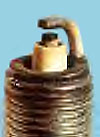 |
A tan coloured plug
means that the engine is running normal and the
air/fuel mixture is correct. This is the correct
color a spark plug should be and it tells you
everything is fine with the engine. You would
install a new properly gapped plug. When installing
a new plug, replace the old one with the same heat
range. This plug shows normal wear in the center
electrode. A new plug would have square edges that
helps the plug fire better. |
|
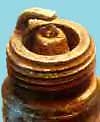 |
This plug is worn out
from being used for a long period of time. Notice
how the center electrode is round and worn from use.
A spark plug that is worn takes a lot more voltage
to fire and can cause poor engine running. |
|
 |
This plug shows what
can happen when something hits the spark plug.
Something from inside the engine has hit the plug
and this problem must be repaired before running the
engine further. Make sure the spark plug is the
correct length for the engine. |
|
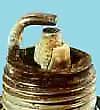 |
Excessive detonation
has caused the porcelain on this plug to break away.
If this engine is allowed to run, engine damage can
occur. Make sure the fuel octane is high enough for
the engines requirements. |
|
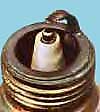 |
A white coloured plug
is caused by engine overheating. Failure to repair
this engine will result in severe engine damage.
Common causes for this are:
Incorrect spark plug (too
hot heat range).
Low octane fuel.
Timing is not set
properly.
Cooling problems, (dirty
cylinder fins, no or low water if water
cooled, low or no engine oil).
Carburetor air/fuel
mixture is too lean (too much air).
Leaking crankshaft seals,
no oil, base or head gasket leaks, or
crankcase leaks on two stroke engines.
|
|
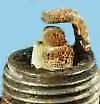 |
This plug has ash
deposits which are light brownish deposits that are
encrusted to the ground and/or center electrode.
This situation is caused by the type of oil used and
adding a fuel additive. This condition will cause a
misfire. This can be also caused by changing oils in
midstream. |
|
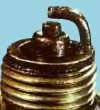 |
This plug is oiled
fouled, caused by poor oil control. |
|
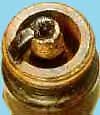 |
Pre-ignition, which
will usually look as a melted center electrode
and/or ground electrode. Check for incorrect heat
range plug, over advanced timing, lean fuel mixtures
or even hot spots or deposit accumulation inside the
combustion chamber. |
|
 |
Sustained
Pre-ignition, which will usually look as a melted or
missing center electrode and/or ground electrode as
well as a destroyed insulator. Check for incorrect
heat range plug, over advanced timing, lean fuel
mixtures or even hot spots or deposit accumulation
inside the combustion chamber. |
|
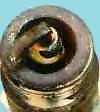 |
Splashed deposits
look as if they are small islands of contaminants on
the insulator. This is usually caused by dirty
carburetor bores or air intake. |
|
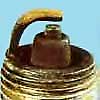 |
A black dry fluffy
coloured plug is caused by deposits from a
carburetor that is running too rich (too much gas),
or excessive idling on some engines. Black smoke
coming from the exhaust is a sign of a rich air/fuel
mixture. The rich air/fuel mixture must be repaired
before installing a new spark plug. Common causes
for a rich air/fuel mixture are:
dirty air filter.
air mixture screw or
carburetor needs adjusting.
choke is sticking.
carburetor float height is
out of adjustment or float is sticking open.
|
Spark plug installation:
Torque is one of the most critical aspects of spark
plug installation. Torque directly affects the spark
plugs' ability to transfer heat out of the
combustion chamber. A spark plug that is under-torqued
will not be fully seated on the cylinder head, hence
heat transfer will be slowed. This will tend to
elevate combustion chamber temperatures to unsafe
levels, and pre-ignition and detonation will usually
follow. Serious engine damage is not far behind.
An over-torqued spark plug can
suffer from severe stress to the Metal Shell which
in turn can distort the spark plug's inner gas seals
or even cause a hairline fracture to the spark
plug's insulator...in either case, heat transfer can
again be slowed and the above mentioned conditions
can occur.
The spark plug holes must always
be cleaned prior to installation, otherwise you may
be torquing against dirt or debris and the spark
plug may actually end up under-torqued, even though
your torque wrench says otherwise. Of course, you
should only install spark plugs in a cool engine,
because metal expands when its hot and installation
may prove difficult. Proper torque specs for both
aluminum and cast iron cylinder heads are listed
below.
|
|
|
|
|
|
Flat seat
type
(with gasket)
|
18 ?mm
|
25.3~32.5
|
25.3~32.5
|
| " |
14 ?mm
|
18.0~25.3
|
18.0~21.6
|
| " |
12 ?mm
|
10.8~18.0
|
10.8~14.5
|
| " |
10 ?mm
|
7.2~10.8
|
7.2~8.7
|
| " |
8 ?mm
|
-- |
5.8~7.2
|
|
Conical
seat type (without gasket)
|
18 ?mm
|
14.5~21.6
|
14.5~21.6
|
|
Conical
seat type (without gasket)
|
14 ?mm
|
10.8~18.0
|
7.2~14.5
|
Gapping
Since the gap size has a direct
affect on the spark plug's tip temperature and on
the voltage necessary to ionize (light) the air/fuel
mixture, careful attention is required. While it is
a popular misconception that plugs are pre-gapped
from the factory, the fact remains that the gap must
be adjusted for the vehicle that the spark plug is
intended for.
Q:
How often should I replace
my spark plugs?
A:
Unfortunately, there is no single answer to this
question. As spark plugs grow older, they lose their
sharp edges as material from the center and ground
electrodes is slowly eroded away. As the gap between
these two points grows, the voltage required to
bridge the gap increases proportionately. Even the
best ignition systems will be strained to supply
enough voltage to completely burn the fuel. It is at
this point, when fuel is being left unburned, that
the time has come to change spark plugs.
Replacing worn out spark plugs
with new ones (with sharp new edges) effectively
restores the ignition system's efficiency. Misfires
are reduced, power is restored, economy of operation
is enhanced and emissions are reduced.
The best guide is the
manufacturer's recommendation for your vehicle, as
this particular service varies from brand to brand
and model to model. In the absence of this
information or in conjunction with it, you can rely
on the advice of a mechanic who is familiar with
your type of vehicle. In the best of all worlds,
this would be a mechanic who is also familiar with
the vehicle you own. If you find a good mechanic,
whether dealer or independent, stick with him. The
better he knows your personal vehicle, the better he
will be able to diagnose and service it. The end
result is very much like a doctor-patient
relationship and, in the long run, you will have a
healthier vehicle.
Q:
What do the numbers and
letters in a part number represent?
A:
The various numbers and letters in a spark plug code
or identification number basically identify the
features and functions of a particular plug.
Included would be information such as plug type,
heat rating, construction, thread diameter, thread
reach and firing end construction.
Click on the link below to
download a guide that will help you decipher the
various NGK alpha-numeric combinations. You will
need to open it with Adobe Acrobat Reader. If you do
not already have Acrobat Reader installed on your
computer, we've provided a link to the free download
area for your convenience.
Download the part number guide
Download Adobe Acrobat
Reader (Free) |
|
|
|
|
|
To view the
pictures, images of the Rotax spark plugs for click on the smaller
images and they will enlarge. To return to the index page for the Rotax spark plugs for click on
Rotax Spark Plug Index link, to view
video of the Rotax spark plugs for click on the Video link, to
return to the Main Index click on the Lightsport Aircraft
Pilot link. |
|
|
|
|
|
|
|
Light Sport Aircraft Pilot News Web Magazine.
You may link to these pages or print
them out for your own personal use.
No part of this
publication may be copied or distributed, transmitted, transcribed,
stored in a retrieval system, or translated into any human or computer
language, in any form or by any means, electronic, mechanical,
manual, or otherwise, without the written permission of Light Sport
Aircraft Pilot News.
By copying or paraphrasing the intellectual
property on this site, you're automatically signing a binding contract
and agreeing to be billed $10,000 payable immediately. Copyright Light Sport Aircraft
Pilot News. Email
|
|